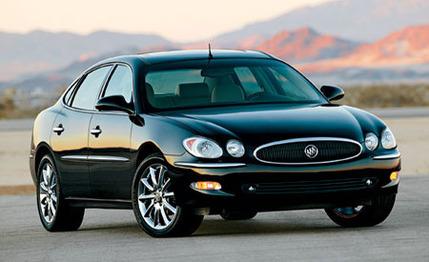
 First Drive Review
First Drive Review
The phase-out of Buick's Century and Regal has not exactly left the automotive world teary-eyed and waxing nostalgic. In their final iteration-excepting the supercharged Regal-the Century and the Regal were left-lane-blocking appliances bearing badges that recalled a more successful era. Admittedly, that's an enthusiast's take on them. In fact, Buick sold a lot of these cars, and their owners were among the happiest in the industry, so the Century/Regal replacement is quite important to the brand.
Buick needn't worry because although the LaCrosse won't find many enthusiast customers, it will not alienate Buick loyalists. The LaCrosse even has the potential to snag a few Chrysler Concorde and Dodge Intrepid drivers turned off by the new 300's beefy styling and rear-wheel drive. Those owners will feel right at home.
Walk around the LaCrosse, and despite its all-new sheetmetal, it looks immediately familiar. Something entirely new that looks familiar? Those are some conservative duds, or there is some imitation at play. It's probably a little of the former and a lot of the latter. Take off those bifocals, gaze upon the C-pillars and taillights, and you'll probably mistake the LaCrosse for a Ford Taurus. Move your eyes to the front end, and you'll see some Concorde and a lot of Lexus GS. The LaCrosse probably won't find many Lexus buyers, but Buick hopes the GS-like split headlights will give customers the impression that this is a far more expensive automobile.
Styling the LaCrosse to look upmarket while keeping the cost down is a good idea that should win over some converts and keep the converted happy. The LaCrosse may crib from other designs, but the end result is cohesive and well proportioned. Even on the base model, the 16-inch wheels and tires nearly fill out the wheel wells and sit almost flush with the fenders.
Under the new sheetmetal is the familiar W-platform that is shared with the Pontiac Grand Prix. Essentially a modified version of the GM10 architecture introduced way back when George Bush the First was running for President, the platform, despite its age, feels stout and quiet, kind of like Jack LaLanne, were he not hawking juicers on TV. Contributing to the renewal is an aluminum front subframe from the Grand Prix that is stiffer and 20 pounds lighter than the previous unit.
Buick attaches two very different V-6 engines to that subframe. There's the stalwart pushrod 200-hp 3.8-liter that comes standard on CX and CXL trim levels, and the CXS's modern 240-hp DOHC 3.6-liter that is also under the hood of the Buick Rendezvous Ultra. The 3.8-liter is now in its third generation and rivals only Methuselah for staying power. Changes to the third-generation 3800 include an electronic throttle, a SULEV emissions rating, and a diminution of five horses when compared with last year's engine. The 3800 gets the LaCrosse going, but the 3.6 is like motivational speaker Tony Robbins: It makes the LaCrosse feel competitive. The DOHC mill sounds better, has a stronger midrange, and will run contentedly to its power peak at 6000 rpm. It's an engine that improves any vehicle it has found its way into and rivals the sixes in the Honda Accord, Toyota Camry, and Nissan Altima.
Buick believes the LaCrosse's interior is in the same league as those you'll find in any Japanese competitor. Beliefs are not always based on reality. Although the interior design and fits are better than in the Century and Regal and the seats are comfortable, the material quality is lacking. Dash plastics were nicely grained, but the gloss varied car to car in the preproduction samples. The faux wood that runs across the dash was insultingly unconvincing, with no gloss or depth. Perhaps these issues will be addressed for the production vehicles.
Owners won't be disappointed by the freshly tuned carry-over strut suspension. Engineers chose slightly stiffer spring rates than those in the Century and Regal-don't fret, they're still pretty soft-and lengthened the rubber bump stops considerably. The springs provide a lot of initial compliance and allow you to float over minor imperfections, but once they are slightly compressed, the rubber bump stops come into play to gradually stiffen the suspension. The LaCrosse sports larger anti-roll bars than the Regal and Century and two different states of suspension tuning. The standard suspension, available on the CX and CXL, no longer leans in corners as did the Buicks of yore and the Koreans of today. In sporty CXS trim, the chassis is firmed up further with a larger rear anti-roll bar and more aggressive P225/55R-17 Goodyear Eagle LS2s. Although the differences sound minor, the CXS feels tauter and more sophisticated than the grandmother-friendly trim levels.
Like many GM products, the LaCrosse is far better than the cars it replaces. But the environment keeps changing as the competition advances. Buick took a safe and conservative approach with the LaCrosse, and the result is not a class-leading must-have. Priced from the low 20s to the mid-30s, aside from the front drive that might appeal to a few Snowbelt sufferers, the LaCrosse doesn't have the value or appeal of the 300. GM product czar Bob Lutz probably won't be fielding any calls from Snoop Dogg trying to "get that brand-new LaCrosse up outta you," and that's probably the way Buick loyalists want it. But who is going to buy a LaCrosse when those Buick owners are gone? That trendsetter Tiger Woods?